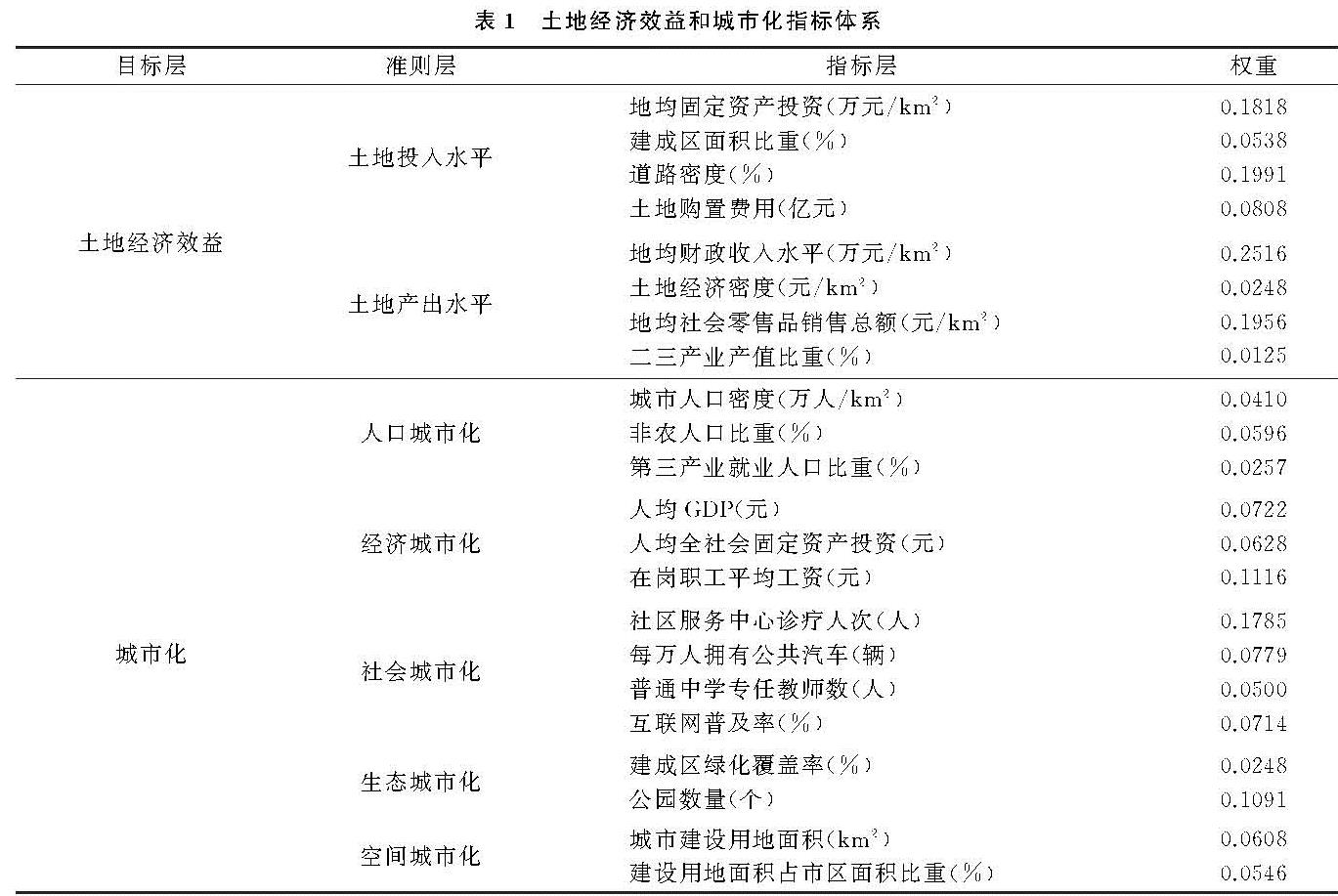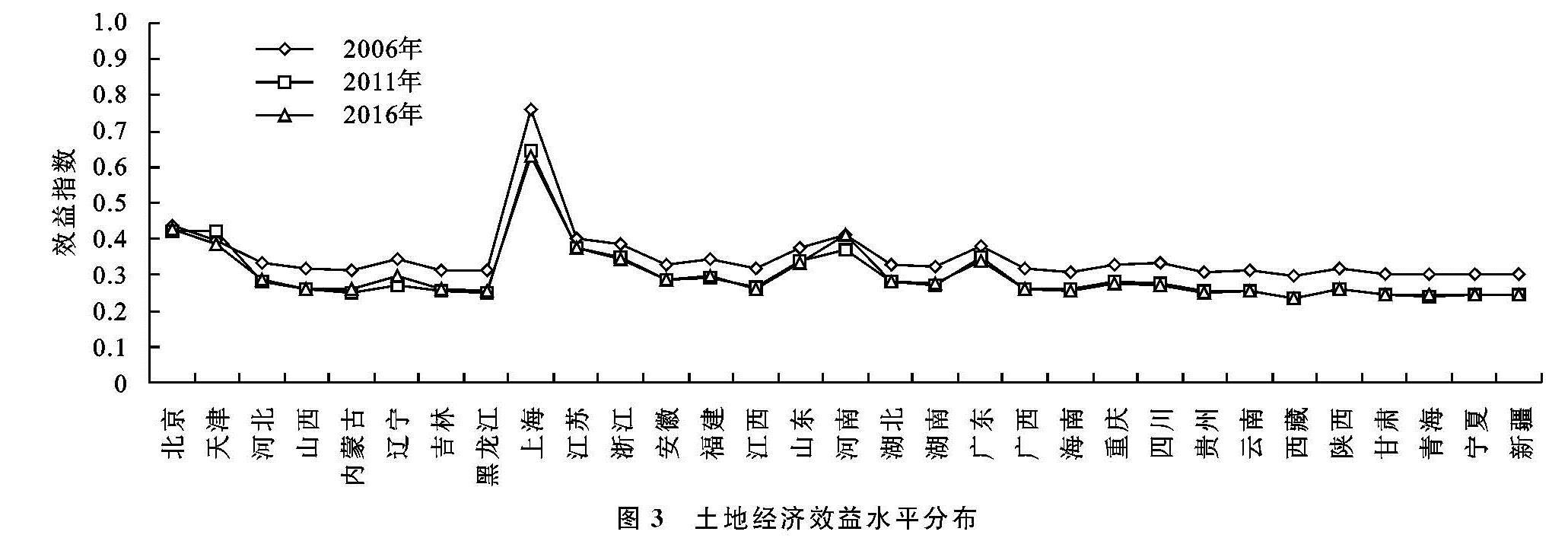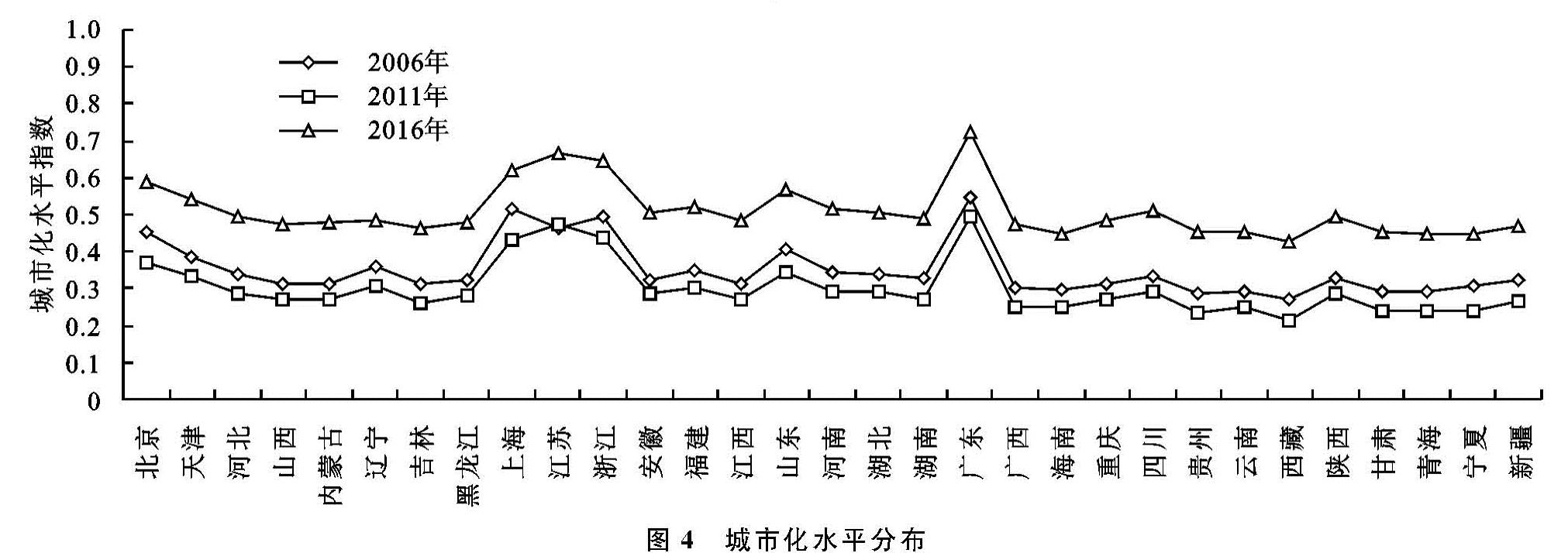3.1 土地经济效益与城市化核密度分布及变化特征
利用ArcGIS 10.2的核密度分析工具,结合自然断点分类法,在已有的研究成果基础上[27-31],将省域进行了点状化处理,制作了基于省域数据的核密度空间分布图,并按照颜色深浅划分为5个等级,即高密度区、较高密度区、中等密度区、较低密度区、低密度区。由图1和图2可知,2006—2016年,土地经济效益高密度区集中独立趋势更加明显,低密度区的空间关联性显著增强,表明全国土地经济效益核密度空间集聚效应减弱,扩散性增强,但各省市的差异逐渐缩小,总体状况趋于改善; 而城市化的核密度空间关联性呈先减弱后增强的趋势,其中高密度区面积先集中后扩散,低密度区面积先扩散后集中,表明全国的城市化水平差异随时间呈先缩小、后增大特征,但总体水平增强。研究结果与我国31省市相应年份的土地经济效益以及城市化发展水平较为一致(图3和图4),均大致以北上广为核心向四周递减。
总体上,土地经济效益和城市化空间分布密度差异均较为显著,且高、低值密度分布区较为一致。从空间上看,土地经济效益和城市化的核密度分布状况均呈现出“东高西低”、“高值区独立且明显、其余密度区向外递减”的分布特征,东部地区各省市核密度层次最为显著,其次为中部地区,西部地区最弱; 从时间上看,核密度随时间呈逐渐缩小趋势,但京津的核心作用增强,这与各地区的土地经济状况和城市社会经济发展状况较为一致。具体来看,土地经济效益和城市化的高密度区有2个块状独立中心,主要分布于东部沿海地区,分别为“北京—天津—河北核密度区”、“上海—浙江北—江苏南—安徽东核密度区”; 较高密度区呈环状,主要分布于东部,分别为山东西、安徽西、河南东、湖北东、江西北、吉林等连续地带; 中等密度区呈片状,主要分布于中部和东部地区,分别为吉林中、黑龙江南、辽宁北、陕西东、甘肃东南、重庆西、宁夏西、青海东、贵州西、广东南、广西南、海南等线状地带; 较低密度区呈片状和块状,主要分布于中部地区,分别为“云南东—四川东—青海东—内蒙古南—陕西西—重庆东—湖南东带状核密度地带”、“新疆核密度区”和“西藏核密度区”; 低密度区呈带状和块状,主要分布于西部和北部,分别为“新疆—西藏—云南西—四川西—青海西—甘肃西—内蒙古北—内蒙古东和黑龙江东带状区”和“山东东块状区”。
3.2 土地经济效益与城市化耦合协调度时空分异格局
通过耦合协调度计算,结合数据大小和范围特征,将2006年、2011年和2016年全国31省市土地经济效益与城市化耦合协调度划分为严重失调(0.0~0.2)、中度失调(0.2~0.3)、轻度失调(0.3~0.4)、濒临失调(0.4~0.5)、勉强协调(0.5~0.6)、初级协调(0.6~0.7)、中级协调(0.7~0.8)、良好协调(0.8~0.9)和高度协调(0.9~1.0)9种类型,见图5。
据图5可知,从不同时间阶段看,耦合协调度发展具有不同的空间分布特征。(1)严重失调阶段。2006年处于该阶段的为新疆、西藏、青海、甘肃、宁夏、云南、贵州等7省,这些省份集中于西部地区,城市化水平较低,土地集约利用化程度偏低,区域耦合协调度优势偏弱; 2011年处于该阶段的省份减少为甘肃、西藏和贵州3省,说明西部地区的耦合协调程度普遍提高; 2016年处于该阶段的数量进一步减少,仅余甘肃和西藏。(2)中度失调阶段。2006年有黑龙江、吉林、内蒙古、河北、山西、陕西、四川、重庆、湖北、安徽、江西、湖南和广西等13省市; 2011年增加宁夏、新疆、青海、云南和海南; 2016年增加辽宁和贵州,但河北、重庆、湖北和安徽4省市发展为轻度失调型。(3)轻度失调阶段。2006年为辽宁、天津、山东、河南和福建5省市; 2011年仅为辽宁、山东和福建3省,河南和天津发展为濒临失调型; 2016年增加从中度失调阶段发展而来的4省市,但辽宁由于土地经济效益与城市化之间的整合能力有所下降,发展为中度失调型。(4)濒临失调阶段。2006年为北京、江苏、广东和浙江4省市; 2011年,增加天津和河南2省市; 2016年,北京发展状态改善,达到勉强协调阶段,其余省市无变化。(5)勉强协调阶段。2006年、2011年涉及的省市均为零; 2016年仅北京1市,表明北京市耦合协调度逐步向有序方向发展。(6)初级协调阶段。在3个时点中均仅为上海,与全国其他省市相比,上海土地经济效益和城市化匹配度相对较高,但协调水平较低,距高水平协调阶段仍有差距。从不同时间点看,全国31省市耦合协调度均随时间呈现趋于向高协调类型转化的趋势,但整体水平不高,协调水平值均处于0~0.7,距中级以上协调仍有差距,未来还有较大的改善空间。从空间演变趋势看,由东部沿海到西部地区协调度呈梯度降低趋势,其中东部沿海区土地经济效益与城市化发展水平均相对较高,呈现出有序发展态势; 中部地区水平居中; 西部地区则由于经济发展滞后,呈现相对无序状态,未来可发展潜力较大。综上所述,严重失调区在各时间点均呈面状或片状分布,其余协调水平区则呈带状分布,其中上海市的耦合协调水平在各时间点均处于全国最高水平。
3.3 土地经济效益与城市化耦合协调度空间聚类及演化特征
根据表3中的全局Moran's I测算结果可知,2006—2016年全国31省市土地经济效益与城市化耦合协调度持续呈现空间集聚状态,高低值协调区域均呈现集中分布的态势,且耦合协调度及集聚的强度随时间呈现先增长后下降的变化趋势。2006—2011年,全局Moran's I值由0.266 7增加到0.319 0,呈快速上升状态,空间相关作用逐渐增强,耦合协调度总体集聚分布态势较为明显; 2011—2016年,全局Moran's I值由0.319 0降低到0.315 8,呈缓慢下降趋势,表明在此期间耦合协调度的空间相关作用和集聚程度开始减弱,但空间集聚状态仍然存在。
根据全局G指数测算结果可知,2006—2016年全国31省市土地经济效益与城市化耦合协调度在空间上存在显著高值集聚区和低值集聚区,说明存在热点区域,土地经济效益与城市化之间互动联系较好。总体上,全局G指数呈“先减少、后增加、轻微振动”变化状态,表明耦合协调度的高低值集聚现象基本保持稳定状态。2006—2016年,全局G指数先由0.074 5减少到0.074 3,后又增加到0.074 7,总体呈现细微变化,表明耦合协调度空间集聚状态呈现先轻微减弱,后又缓慢增强的趋势,但基本变化不大。
表3 土地经济效益和城市化耦合协调度空间自相关分析
3.4 土地经济效益与城市化耦合协调度热点分析
结合ArcGIS 10.2热点分析工具,在全局Moran's I指数计算基础上,采用自然断点分级法将热点区域划分为7类,包括热点高显著区、热点中显著区、热点低显著区、冷点高显著区、冷点中显著区、冷点低显著区和随机分布区,见图6。从离散的观测点中判断其空间异质性特征,并根据数据大小分析其冷热点集聚区域分布和随时间演化转变的特征。
由图6可知,从不同时间阶段看,耦合协调度冷热点发展具有不同的空间分布特征。(1)显著热点区。2006年有15个,其中位于热点高显著区的为山东、安徽和江苏3省,这些区域土地经济效益与城市化之间联系密切,形成高值集聚区域; 位于热点中显著区的为河北、天津、河南、湖北、江西、福建、浙江和上海8省市; 位于热点低显著区的为内蒙古、北京、山西和辽宁4省市。2011年有16个,热点高显著区增加河北、湖北、上海和浙江4省市; 热点中显著区变为内蒙古、辽宁、北京、天津、河南、江西和福建7省市,范围波动较大; 热点低显著区变为山西和吉林2省。2016年显著的热点区有17个,热点高显著区未发生变化; 热点中显著区,除北京发展为热点低显著区外,又增加山西,整个沿海区域在上海、江苏等地带动下形成高值集中分布区; 热点低显著区变为陕西、湖南和北京3省市,原有省份发展为热点中显著区。(2)显著冷点区。2006年有11个,冷点高显著区仅有四川; 冷点中显著区包括新疆、甘肃、青海、西藏、云南和重庆6省市; 冷点低显著区包括宁夏、贵州、广西和海南4省,这些区域土地经济效益与城市化关联较弱,并形成低值区域。2011年显著的冷点区有10个,除冷点低显著区变为重庆、广西、广东和海南4省市,变动较大,其余类型没有变化。2016年显著的冷点区有9个,冷点高显著区消失; 冷点中显著区变为新疆、甘肃、青海、西藏和四川5省; 冷点低显著区变为宁夏、云南、黑龙江和重庆4省市,原有的广西、广东和海南向上一等级发展。(3)随机分布区。2006年为陕西、湖南、广东、黑龙江和吉林5省,这些区域土地经济效益与城市化之间联系度较弱,处于冷点与热点过渡区域,其中,广东由于其开放时间较早,城市化超前于土地经济效益,二者之间差距较大,因此未形成热点区域; 2011年为宁夏、陕西、贵州、湖南和黑龙江5省,原有的广东降至冷点低显著区,而吉林由于土地经济效益与城市化之间联系增强,发展为随机分布区; 2016年为贵州、广西、广东、海南和吉林5省,与上一阶段相比,除贵州省以外,原有省份均发生变化,其中宁夏和黑龙江下滑为冷点低显著区,陕西和湖南发展为热点低显著区。从不同时间点看,冷热点区范围随时间均发生较大波动,热点显著区数量逐渐增多,冷点显著区数量逐渐减少,高、低值集聚区逐渐趋于集中分布。从空间上看,热点区域总体呈从东部沿海到西部地区热度逐渐降低的趋势,高值集聚区即显著的热点区主要集中于东部沿海及周边区域,低值集聚区即显著的冷点区主要分布于西部地区,其余为随机分布区。从面积占比看,所占比例最大和最小的分别为热点显著区和随机分布区。从分布形态上看,冷热点集中区均呈片状分布,随机分布区则呈带状分布。未来仍需努力发挥热点区域的正向辐射带动作用,积极进行城市建设,发掘用地潜力,提高土地集约利用和经济效益水平; 同时西部地区要积极引用外资,加强区域间合作,以促进全国整体城市化水平的提高。
3.5 土地经济效益与城市化耦合协调度趋势面分析
利用地学统计方法进行的立体趋势面分析可知,2006—2016年期间,全国31省市的耦合协调度均呈现“东高西低、中部高南北低”的空间分布趋势,在2006—2011年,趋势面变化较为明显,2011—2016年则相对平稳。具体而言,在南北方向上呈弧度与坡度不断增大的倒“U”型曲线,且南方大于北方,表明中部地区城市土地经济效益与城市化良性互动强度较南方和北方好,但南方优于北方; 在东西方向上呈一条由西到东逐渐增高的斜线,且斜线的弧度与坡度随时间逐渐增大,最高值呈现不断上涨态势,表明全国东部省市耦合协调发展良性程度优于中西部地区省市,差异逐年增大。上海、浙江等地由于经济发展水平和土地经济效益均比较高,属于高协调优势区; 而河南、湖北等一些经济发展相对落后省市,土地经济效益也较低,但耦合协调程度相对较高,属于高协调劣势区。通过分析可知,土地经济效益与城市化耦合协调空间指向性明显,高值区主要集中于东部沿海及周边区域地带,成为土地与经济发展的良性互动优势地带。









